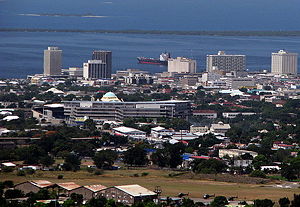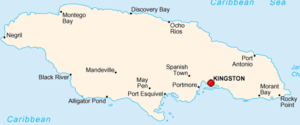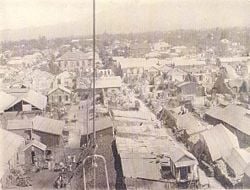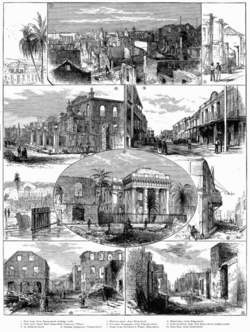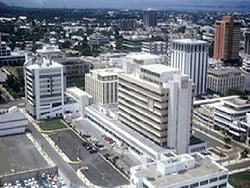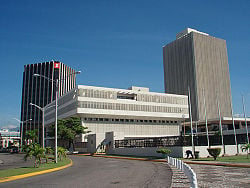Kingston, Jamaica
| City of Kingston | |
| Downtown Kingston and the Port of Kingston | |
| Motto: A city which hath foundations[1] | |
| Location of Kingston shown within Jamaica | |
| Coordinates: 17°59′N 76°48′W | |
|---|---|
| Country | |
| County | Surrey |
| Parish | Kingston St. Andrew |
| Established | 1692 |
| Government | |
| - Mayor | Desmond McKenzie |
| Area | |
| - Total | 480 km² (185.3 sq mi) |
| Elevation | 9 m (30 ft) |
| Population (2001) | |
| - Total | 651,880 |
| - Density | 1,358/km² (3,517.2/sq mi) |
| - Kingston Parish | 96,052 |
| - St. Andrew Parish | 555,828 |
| Time zone | EST (UTC-5) |
Kingston is the capital and largest city of Jamaica and is located on the southeastern coast of the island country.
The local government bodies of the parishes of Kingston and St. Andrew were amalgamated by the Kingston and St. Andrew Corporation Act of 1923, to form the Kingston and St. Andrew Corporation (KSAC). Greater Kingston, or the "Corporate Area" refers to the KSAC; however, it does not solely refer to Kingston Parish, which only consists of the old downtown and Port Royal. Kingston Parish had a population of 96,052, and St. Andrew had a population of 555,828 in 2001.[2]
Several reggae stars, including Buju Banton, Sean Paul, Bounty Killer, and Beenie Man, hail from Kingston. Attractions include the nearby Hellshire and Lime Cay beaches, the National Gallery of Jamaica, the ruins of Port Royal, and Devon House, a mansion with adjoining park that once belonged to Jamaica's first black millionaire. Several annual and well-visited festivals are held in Kingston.
Geography
Etymology of name – if available. It faces a natural harbour protected by the Palisadoes, a long sand spit which connects Port Royal and the Norman Manley International Airport to the rest of the island.
Kingston is surrounded by the Blue Mountains, Red Hills, Long Mountain and the Kingston Harbour. The city is sited on the Liguanea Plain, an alluvial plain located next to the Hope River. Kingston experiences frequent earthquakes, including the 1907 earthquake.
Elevation
Jamaica has a tropical climate with year round constant high temperatures and humidity and no seasonal variation. The city of Kingston lies on the dry part of the island, so rainfall is intermittent. When it does rain, showers are short, heavy and followed by sunshine. The rainiest weather occurs in May and June and later in October and November, sometimes extending into December. Tropical storms and hurricanes can occur between July and November.
The city (Johannesburg) enjoys a dry, sunny climate, with the exception of occasional late afternoon downpours in the summer months of October to April. Temperatures are usually fairly mild due to the city's high altitude, with the average maximum daytime temperature in January of 79°F (26°C), dropping to an average maximum of around 61°F (16°C) in June. Winter is the sunniest time of the year, with cool days and cold nights. The temperature occasionally drops to below freezing at night, causing frost. Snow is rare. Mean annual precipitation is 28 inches (716mm).
Rivers and canals Size – land area, size comparison Environmental issues
The city proper is bounded by Six Miles to the west, Stony Hill to the north, Papine to the northeast and Harbour View to the east. Communities in rural St. Andrew such as Gordon Town, Mavis Bank, Lawrence Tavern, Mt. Airy and Bull Bay would not be described as being in Kingston.
Two parts make up the central area of Kingston: the historic but troubled Downtown, and New Kingston.
Kingston has a tropical climate, characterized by a wet season from May to November, which coincides with the hurricane season, and a dry season from December to April. During the dry season, there is not much rainfall, however, cold and stationary fronts occur at this time, and often bring heavy showers, especially in March. Kingston is located in the rain shadow of the Blue Mountains; therefore, little to none of the moisture of the Northeast Trade Winds carry falls over Kingston, causing Kingston to be very dry in comparison to Portland and Saint Mary on the windward side of the Blue Mountains. Kingston is on a coastal location, hence it comes under the influence of the sea, though dense urban development can negate this effect. In the 21st century, Kingston has experienced temperatures as high as 34°C (93.2°F) and temperatures as low as 25°C (77°F). Between 1895 and 1990, the total average rainfall was recorded at 909.7 mm (35.8 inches), the highest monthly average rainfall recorded in October at 181.1 mm (7.1 inches), and the lowest monthly average rainfall recorded in March at 22.7 mm (0.9 inches). [3]
History
Kingston was founded on July 22, 1692, as a place for refugees and survivors of the 1692 earthquake that destroyed Port Royal. Before the earthquake, Kingston’s functions were purely agricultural. The earthquake survivors set up a refugee camp on the sea front. Approximately two thousand people died due to mosquito borne diseases. Initially the refugees lived in a tented camp on Colonel Barry's Hog Crawle. The town did not begin to grow until after the further destruction of Port Royal by the Nick Catania Pirate Fleet's fire in 1703. Surveyor John Goffe drew up a plan for the town based on a grid bounded by North, East, West and Harbour Streets. By 1716 it had become the largest town and the centre of trade for Jamaica. The government sold land to people with the regulation that they would purchase no more than the amount of the land that they owned in Port Royal, and only land on the sea front. Gradually wealthy merchants began to move their residences from above their businesses to the farm lands to the north on the plains of Liguanea.
The first free school, Wolmer's, was founded in 1729 [4] and there was a theatre, first one in Harbour Street and then moved in 1774 to North Parade. Both are still in existence. In 1755 the governor had decided to transfer the government offices from Spanish Town to Kingston. It was thought by some to be an unsuitable location for the Assembly in close proximity to the moral distractions of Kingston, and the next governor rescinded the Act. However, by 1780 the population of Kingston was 11,000, and the merchants began lobbying for the administrative capital to be transferred from Spanish Town, which was by then eclipsed by the commercial activity in Kingston.
At the end of the 18th century, more than 3000 brick buildings were in the city. The harbour fostered trade and naval wars of the 18th century. Kingston took over the functions of Spanish Town (the capital at the time). These functions included, agriculture, commercial, processing, and a main transportation hub to and from Kingston and other sections of the island.
The government passed an act to transfer the government offices to Kingston from Spanish Town, and in 1872 the capital was transferred from Spanish Town to Kingston. It kept this status when the island was granted independence in 1962.
In 1907, 800 people died in another earthquake known as the 1907 Kingston earthquake, destroying nearly all the historical buildings south of Parade in the city. That was when a restriction of no more than 60 feet (18 m) was instated on buildings in the central business district. These three story high buildings were built with reinforced concrete. Construction on King Street in the city was the first area to breach this building code.
During the 1930s, island wide riots lead to the development of trade unions and political parties to represent workers.
The city became home to the Mona campus of the University of the West Indies founded in 1948 with 24 medical students.
It wasn’t till the 1960s that major change occurred in the redevelopment of Kingston’s central business district. The international attention of reggae music at that time coincided with the expansion and development of 95 acres (380,000 m²) of the Downtown Kingston water front area.
These developments lead to an influx of shops and offices, and the development of a new financial center: New Kingston, which replaced the Knutsford Racetrack. Multi-story buildings and boulevards were placed within that section.
In 1966 Kingston was the host city to the Commonwealth Games.
The westward section of the city was not the focus of development, and that area proved to be a tense area in political times. The 1970s then saw deteriorating economic conditions that led to recurrent violence and a drop off in tourism which later affected the island.
In the 1980 general elections, the democratic socialist People's National Party (PNP) government was outvoted. The subsequent governments have been open market oriented since the 1980s. Within a global urban era, the 1990s saw that Kingston has made efforts to modernize and develop its city structure and functions. Various organizations such as The Kingston Restoration Company, the Urban Development Corporation (UDC) and the Port Authority of Jamaica, along with the Port Royal Development Company, among others sought to develop the urban structure of the city.
Modern development
Today, the city of Kingston sees that the original waterfront area along Harbour Street, once redolent with the aromas of colonial West Indian trade in rums and spices, has been re-developed. Shipping has moved to Newport West, adjacent to the extensive Kingston Industrial Estate.[2]
A great deal of Kingston is pure shanty town, but again one sees striking contrasts, especially in New Kingston, situated between the teeming downtown and mid town areas and the fading but still gracious suburbs of St. Andrew.
The city’s wealthy residents are situated in the suburbs to the north of Kingston, closer to the hills and mountains of the Blue Mountains range. The needs of the wealthy are met by the New Kingston, Manor Park and Barbican / Liguanea areas, and so the downtown is now used mostly by the low-income population. [2]
New Kingston is a business area which embodies the best of modern tropical town planning, graciously combining high rise buildings and well-groomed gardens with the soaring Blue Mountains as a backdrop.
Government
Economy
The Jamaican economy is heavily dependent on services, which account for more than 60 percent of GDP. The country continues to derive most of its foreign exchange from tourism, remittances, and bauxite/alumina. Remittances account for nearly 20 percent of GDP and are equivalent to tourism revenues.
Jamaica's economy, already saddled with a record of sluggish growth, faces serious long-term problems: high but declining interest rates, increased foreign competition, exchange rate instability, a sizable merchandise trade deficit, plus large-scale unemployment and underemployment.
Jamaica's onerous debt burden - the fourth highest per capita - is the result of government bailouts to ailing sectors of the economy, most notably the financial sector in the mid-to-late 1990s.
Per capita GDP was estimated at $7,400 in 2007.
Kingston, as the capital, is the financial, cultural, economic and industrial centre of Jamaica. Many financial institutions are based in Kingston, and the city boasts the largest number of hospitals, schools, universities and cultural attractions of any urban area on the island. Some notable landmarks in Kingston include, the University of the West Indies, Jamaica Defence Force Museum, Bob Marley Museum and Hellshire Beach
Financial and business services sector Tourism Manufacturing Transport: Road, rail, air, sea The city is a hub for Germany’s and Europe’s high-speed passenger rail network.
Autobahns radiate from Cologne's ring road.
Kingston is served by Norman Manley International Airport and also by the smaller and primarily domestic Tinson Pen Aerodrome.
The Rhine harbor is one of the larger inland ports in Germany.
Public transport within the city includes buses, a subway system, and the Rheinseilbahn aerial tramway crossing the Rhine. Cologne has pavement-edge cycle lanes linked by cycle priority crossings.
Demographics
The largest percent of the population is of African heritage. East Indians are the second largest ethnic group, followed by Chinese, European, and Arab (primarily Lebanese). A small number of Hispanics, mostly from Latin America, also reside in the city.
There are a wide variety of Christian churches in the city. Most are Protestant, a legacy of British colonization of the island. The chief denominations are Church of God, Baptist, Anglican, Methodist, Roman Catholic, Seventh-day Adventist, and Pentecostal. Afro-Christian syncretic religions are also widespread.
There is a Jewish synagogue in the city as well as a large number of Buddhists and Muslims.
Law
The Jamaica Constabulary Force, Jamaica's police force, is based on Old Hope Road near Liguanea. Smaller police stations, such as Hunt's Bay, Matilda's Corner and Half-Way-Tree, are dispersed across the Corporate Area. The Supreme Court of Jamaica is also located in Kingston. Other courts, such as the Half-Way-Tree Resident Magistrate's Court, Gun Court, Traffic Court and Family Court, make Kingston their home. The Jamaica Defence Force (JDF) has its headquarters at Up Park Camp near New Kingston and Cross Roads. The JDF also operates a major naval base at Port Royal.
Media and Communications
The Gleaner Company, the Jamaica Observer and the Sunday Herald, three of Jamaica's large newspaper companies, make their home in Kingston. Several television and radio stations including Television Jamaica (TVJ), CVM TV, RJR 94 FM, Hitz 92 FM, FAME 95 FM, LOVE TV, ZIP 103, Kool 97 FM and LOVE FM, are all based in Kingston. Kingston generally has an adequate telecommunications service, administered by either Cable and Wireless or Flow Jamaica. Cellular phone service is also very strong in Kingston, especially since Cable & Wireless, Digicel and MiPhone, Jamaica’s three cellular providers, are all based in the city.
Notable residents
Looking to the future
Does the city face no challenges or offer up anything else as a legacy?"
Does the city need reconstruction?
Is it a model city?
Will it run out of water?
Does it have a crucial role to play in the nation?
High unemployment exacerbates the serious crime problem, including gang violence that is fueled by the drug trade. The government faces the difficult prospect of having to achieve fiscal discipline in order to maintain debt payments while simultaneously attacking a serious and growing crime problem that is hampering economic growth.
ReferencesISBN links support NWE through referral fees
- ↑ KSAC lauds contribution of century- old churches downtown
- ↑ 2.0 2.1 2.2 Brief history of Kingston, Jamaica Cite error: Invalid
<ref>tag; name "kingston" defined multiple times with different content - ↑ Kingston/NormanManleyClimate
- ↑ Wolmer's Boys School
External links
| North America Portal |
- Jamaica Library Service: brief history of Kingston
- 2001 Census
- History
- Ministry of Health
- Jamaica National Heritage Trust
- The Tramways of Kingston, Jamaica
- Kingston climate Retrieved January 3, 2009.
Credits
New World Encyclopedia writers and editors rewrote and completed the Wikipedia article in accordance with New World Encyclopedia standards. This article abides by terms of the Creative Commons CC-by-sa 3.0 License (CC-by-sa), which may be used and disseminated with proper attribution. Credit is due under the terms of this license that can reference both the New World Encyclopedia contributors and the selfless volunteer contributors of the Wikimedia Foundation. To cite this article click here for a list of acceptable citing formats.The history of earlier contributions by wikipedians is accessible to researchers here:
The history of this article since it was imported to New World Encyclopedia:
Note: Some restrictions may apply to use of individual images which are separately licensed.
